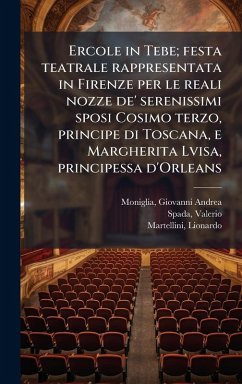Ercole in Tebe is a theatrical celebration composed for the wedding of Cosimo III de Medici, Prince of Tuscany, and Marguerite Louise d'Orléans in 1661. Written by Giovanni Andrea Moniglia with music by Valerio Spada and stage design by Lionardo Martellini, this work exemplifies the grandeur of Florentine courtly entertainment during the Baroque era. The libretto, filled with mythological allusions and allegorical figures, showcases the power and prestige of the Medici family. This historical document offers insights into the artistic tastes and political ambitions of one of Italy's most influential dynasties, providing a valuable resource for scholars of opera, theater, and European history. This work has been selected by scholars as being culturally important, and is part of the knowledge base of civilization as we know it. This work was reproduced from the original artifact, and remains as true to the original work as possible. Therefore, you will see the original copyright references, library stamps (as most of these works have been housed in our most important libraries around the world), and other notations in the work. This work is in the public domain in the United States of America, and possibly other nations. Within the United States, you may freely copy and distribute this work, as no entity (individual or corporate) has a copyright on the body of the work. As a reproduction of a historical artifact, this work may contain missing or blurred pages, poor pictures, errant marks, etc. Scholars believe, and we concur, that this work is important enough to be preserved, reproduced, and made generally available to the public. We appreciate your support of the preservation process, and thank you for being an important part of keeping this knowledge alive and relevant.
Bitte wählen Sie Ihr Anliegen aus.
Rechnungen
Retourenschein anfordern
Bestellstatus
Storno

